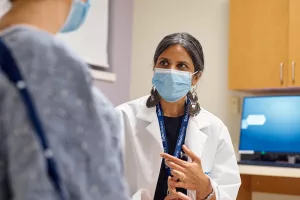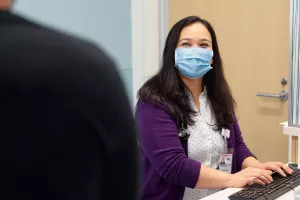When the heart isn’t pumping enough blood, mechanical circulatory support can step in to help. A ventricular assist device (VAD) is one kind of mechanical circulatory support. It’s a pump that helps the heart send blood to the rest of the body, making sure organs like the brain and kidneys get the blood they need. Mechanical circulatory support helps the heart work better until it’s strong enough on its own.
Ventricular assist device + mechanical circulatory support for heart failure: Improving heart function
Heart failure happens when the heart can’t pump blood properly. In systolic heart failure, the left side of the heart (the main pumping chamber) can’t push blood out with each heartbeat. One option to help improve heart function is mechanical circulatory support. This includes devices like the ventricular assist device (VAD), which is a mechanical pump surgically placed in your chest. A VAD doesn’t replace your heart, but it helps pump enough blood throughout your body.
The most common type of VAD is the left ventricle assist device (LVAD), which helps the left side of the heart pump blood to the body, keeping organs like the brain and kidneys healthy. Mechanical circulatory support, including VADs, can help improve your quality of life and extend it, giving your heart the support it needs.

Conditions
Mechanical circulatory support includes devices that help your heart pump blood when it can’t do the job on its own. These include ventricular assist devices (VADs), such as a left ventricular assist device (LVAD), as well as total artificial hearts and extracorporeal membrane oxygenation (ECMO).
If you have heart failure, cardiogenic shock, or if your heart isn’t pumping enough blood, you may need mechanical circulatory support to help it work better. An LVAD can support your heart until it recovers or until a long-term solution like a heart transplant is possible. Conditions that may be treated with a ventricular assist device include:
Treatments
If your heart failure symptoms have gotten worse, we might recommend a left ventricular assist device (LVAD) to help your heart pump blood and improve circulation. LVADs are often used for patients with severe heart failure with reduced ejection fraction (HFrEF), where the heart struggles to pump blood properly. These devices can help you live longer, feel better and do more. However, LVADs may not be right for everyone, especially if you have other serious health problems.
Knowing your options can help you make the best choice for managing heart failure and improving your heart health. Whether you need short-term or long-term support, these ventricular assist devices are made to help your heart.
An LVAD is made up of several key components that work together to assist your heart:
- Controller: Provides power to the pump inside the heart and shows information about the pump's settings, including alarms if something goes wrong.
- Driveline: An electrical cord that connects the pump to the controller and power supply. The driveline exits through the skin and needs to be covered with clean bandages (sterile dressings) to avoid infection.
- Power supply: The controller gets power from either batteries or a cable that plugs into a wall outlet.
Before leaving the hospital, the cardiac team at Tufts Medicine will provide you and your caregivers with training on how to manage the LVAD at home.
Temporary mechanical cardiac support for heart failure
If you are very sick because of heart failure, temporary devices may be used to help your heart and lungs work until they recover. These devices are typically put in with minimally invasive procedures and must be closely monitored in the hospital, especially in the intensive care unit (ICU). They help stabilize your condition while you wait for recovery, a heart transplant, or long-term support like an LVAD.
Some of the temporary devices used for heart support include:
- Intra-aortic balloon pumps (IABP): This device helps the heart pump blood more easily by inflating and deflating a balloon inside the main artery, improving blood flow to the heart and other organs.
- Impella device: A small pump placed inside the heart to help it pump blood when it can’t do the job on its own.
- ECMO (extracorporeal membrane oxygenation): A machine that helps when the heart and lungs are too weak to work on their own. It takes blood out of the body, adds oxygen, removes carbon dioxide then gently pumps the clean blood back in. This gives the heart and lungs time to rest and heal.
These devices provide critical, temporary help for your heart and lungs while you wait for other treatments. They can stabilize your condition until your heart recovers, you receive a heart transplant or you’re ready for long-term solutions like an LVAD.
Long-term mechanical circulatory support
For long-term circulatory support, the Abbott HeartMate 3 LVAD is the only FDA-approved device that allows you to be discharged from the hospital and live with the device at home. This device is ideal for those waiting for a heart transplant or needing long-term help managing heart failure. The HeartMate 3 LVAD provides continuous support to help the heart pump blood, which can improve heart function, relieve symptoms and enhance quality of life.
It helps those with severe heart failure by giving the heart the extra support it needs to keep working. While waiting for a heart transplant or as an ongoing treatment, the HeartMate 3 LVAD offers a better, more stable life.
FAQs
Your care team will evaluate your condition and determine the best option for you. Currently, the only FDA-approved device available is the Abbott HeartMate 3. However, investigational devices may sometimes be accessible through participation in a clinical trial.
It depends on what and how the LVAD will support you and your care. There are 2 reasons a LVAD may be recommended:
- Bridge therapy: Designed to keep you stable and physically active as you wait for a heart transplant or until the heart function recovers. The LVAD is temporary and removed.
- Destination therapy: In cases of end-stage heart failure, the LVAD can be a permanent solution when a heart transplant is not an option. In these situations, it is unlikely that the LVAD will be removed unless the heart has fully recovered.
Battery life can last between 8-14 hours. Each LVAD comes with 3 sets of batteries, so you can go freely about your day without worrying about recharging batteries. To prevent your LVAD's battery from draining, it is recommended to connect it to a power source (to a wall outlet) while you sleep at night.
Some people are able to return to work depending on their job responsibilities. We strongly recommend speaking with your doctor first before returning to work.
Traveling with an LVAD is possible and requires thoughtful planning. You can even go on airplanes. We can provide local contact information for LVAD hospitals should a visit be necessary.
People with an LVAD are able to drive once fully healed, which is about 8–10 weeks after after surgery. Your care team will need to clear you before you start driving again.
No, you cannot go swimming if you have an LVAD.
Showering is possible about 6 weeks after surgery with the use of protective equipment to prevent the controller and batteries from getting wet.
Receiving an LVAD requires a big commitment for you, your caregiver and your medical team. You must have full-time support at home with a caregiver knowledgeable about caring for the device in emergencies for the first several weeks and months after the surgery.
Certain patients may need to be transferred to an acute rehabilitation hospital before they can go back home. Typically, long-term care facilities for patients with LVAD are not available for those who still require significant support at home. It's very important for you to have support in place before your surgery in case of a major complication and you're unable to care for yourself.
While recovering from surgery, you will typically require some help from caregivers once they leave the hospital. We expect that most who receive an LVAD will return to an independent lifestyle, but some long-term help may be required for specific care tasks, such as changing the driveline bandage. After surgery, most will need full-time help from a caregiver for a few weeks.
We'll provide you and your caregiver with education on:
- How to transition between power sources: batteries vs the power cable.
- How to respond to LVAD alarms and when to contact their medical team.
We will make sure that you have the needed resources before you leave the hospital to minimize risk of long-term complications and to optimize your safety and well-being. You will have a full set of backup equipment at home should an emergency arise.
LVAD therapy requires chronic anticoagulation (blood thinners) and we'll help you manage these medications. You will see your care team often after your surgery — initially once a week and then gradually less as you recover from your surgery and become comfortable with your new lifestyle. You will generally be seen at least every 3 months for long-term care and as needed.
Locations

From regular office visits to inpatient stays, find the healthcare you need and deserve close to home.

Meet the doctors and care team devoted to supporting you every step of the way along your path to better health.